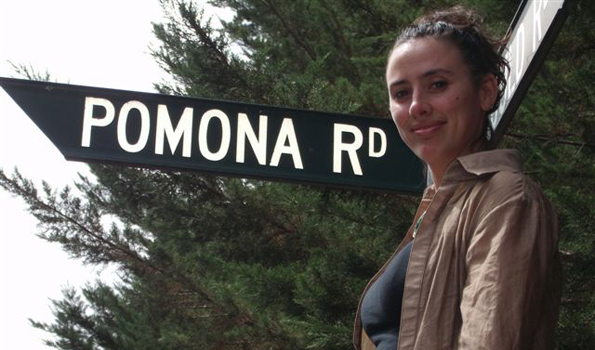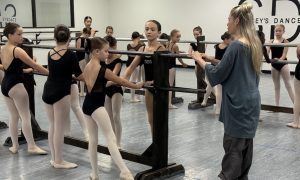By Jo McDonald
Katrina Lazaroff’s first full-length work, Pomona Road, will be presented in association with Adelaide Festival Centre’s inSpace program this April. In the lead up to the work’s premiere, Katrina spoke to Jo McDonald about developing Pomona Road, her choreographic process and the dream of directing her own company.
What inspired you to create Pomona Road?
I had just finished being in a fulltime dance company and wanted to create for myself again. I tried a few choreographic explorations that became really technical and weren’t communicating very well. But I wanted to make something that is inspiring and fun. I started thinking back to music tracks I loved when I was young that I used to dance to with my sister. That’s when I really started to love dance and music. So I decided to make a piece about my sister and me, and our explorations as kids and our relationship, the sibling rivalry, jealousy, love, mateship and joy. That was here at Pomona Road, where we moved after the fire. It’s where my childhood began. Created and performed in Perth with Strut Dance, the piece was mostly movement and dance but had some live text in it and a soundscore. From there I thought there’s something in this and people started to get quite excited.
Then I started to explore the male relationships in my family – my father and brother, and made a 20 minute duo that had a full season at the Blue Room Theatre. It was mainly about looking at where you come from, your background and how the relationships in your family affect who you are. That was called Part II.

Katrina Lazaroff. Photo Jo McDonald
Then the picture of the full length work started coming into my mind and how I’d make a work with five or six people. Part one and two were done in Perth and then I moved back to Adelaide. I ended up doing Part three and the final development in 2009. Part one, two and three have become the full length work.
How important was that process of presenting it and then revisiting it before further developing the work?
It’s become more and more important as I’ve had this opportunity to build a work over a long time. I’m working with four designers and a dramaturge. In all those artistic collaborations there is a lot of discussion and time to look back, talk to these people and ask how we can improve what we’re doing. It’s been a real luxury to have the time to look on it that way.
Have you found that your vision has just evolved?
Yes it has. It’s almost like this puzzle that I’ve been piecing together. Beautiful spontaneous synchronistic things happen. It’s like an unfolding story, like it’s already been done and I’m just sort of pulling it out.
Do you plan things upfront or just explore ideas as they come along?
I think I’m a bit of both. I know what I like and I know what choreography I relate to and what I like to see. I aim for something that is well crafted, but I sort of go with the moment and what the dancers and other artists offer and what’s coming to me at that time, so it flows well. Otherwise it can be forced and that’s when things are too abstract and they don’t relate to anything.
How do you progress your initial idea? Is it always the same or completely different?
There is some similarity in my process, but it is the meaning of the work that inspires me, which makes it different every time. Although the more I choreograph the more I realise there are things that work really well that I’ll keep using over the years, like a tool kit. I like doing work in the theatre side of dance, with speaking, text, characterization and personal history.
We have a lot of discussion about each dancer’s past so they have real reference to the work, rather than it being pasted on. Those discussions often end up in the work and I shape them so it fits my work. Pomona Road Part 2 was based very much on researching the relationships the guys had with their fathers and how that impacts who they are.
The beauty of Pomona Road as a full length work is that I thought about an experience my family had been through that I could use to tell a real story, and that was the Ash Wednesday Bushfires. It’s been amazing to research and revisit to understand myself. How does a trauma like that affect a family? Do they rebuild? Do they stay together or break apart? How does it affect the internal dynamics? That was my interest.
I ended up interviewing my parents and a few other bush fire victims from the 1983 fire. We were burnt out in 1980. In the interviews their stories came out. That was incorporated into Pomona Road Part 3 and was one of the strongest elements of the work. It’s helped me learn about a new form of narrative that is layered on top of the dance, characterization and live text. It drives the show, but it’s not a direct link. The father speaking is not a direct link to the father performing. It’s not haphazard, but layering. We’ve called it documentary dance, because it’s depicting an event from the past.
Has this been your most significant work to date?
Yes. It’s the first full length work, which is really difficult to do as an independent artist. Although it’s a short season, it’s a massive step.

Katrina Lazaroff. Photo Jo McDonald
Do you plan to continue as an independent, work for an existing company, or do you have the temptation to form your own company?
I do have the temptation. I’d like to build a small company. Although I’m also quite aware that there’s not a huge packet of money for funding over a long period to form a new company, so I’m realistic. I figure that as long as I’m making work that I believe in and remain passionate, it will all unfold.
What would your ideal company look like?
I think it would be a group of six dancers, possibly eight but I know that’s a little unrealistic, with a collaborative team of designers, musicians, visual artists and lighting designers. I’d like to work with dancers or actors who are more driven to act than just move. I love the highly trained technical dancer, but also the type of performer who’s willing to access who they are, to speak and sing and touch all different levels of performance.
As you find those people, what do you do to nurture that relationship and keep them involved in your work?
I offer my Wednesday contemporary class at Ausdance for free. Sometimes I invite my dancers to come to ADT if I am teaching there. I talk to them about their direction and where they want to go, help them work out who they need to talk to and which classes they need to go to. It’s not just getting them to be ready for my work, but getting them to be inspired and driven people so that when I do work with them they are on the move. It’s hard to push people when you’re not paying them daily or often, so you have to have really good relationships.
Where to from here? What’s the dream?
I’d love to direct a major dance company in Australia. I know how hard it is, and how much time is spent in administration, but I feel like I could get that right with the support of an organisation. I love dancers. That’s what makes me tick. I don’t see them as tools, I see them as inspiration for the work. So I do see myself directing a company in Australia, whether that’s one I create myself or a position I apply for. It’s about staying human. I would love to be able to offer my care and love to dancers in a company, as well as my creative side.
Make sure you get your tickets to see Pomona Road.
Dates: April 21st – 24th
Venue: Space Theatre, Adelaide Festival Centre
Contact: BASS 131 246 www.bass.net.au









